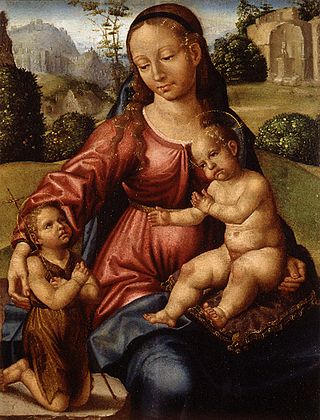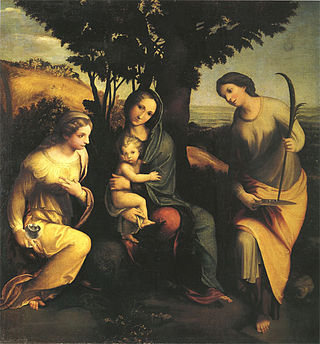Related Research Articles

Reggio di Calabria, commonly and officially referred to as Reggio Calabria, or simply Reggio by its inhabitants, is the largest city in Calabria as well as the seat of the Regional Council of Calabria. It has an estimated population between 150,000 and 200,000 and is the twenty-first most populous city in Italy, after Modena and other Italian cities, and the 100th most populated city in Europe. Reggio Calabria is located near the center of the Mediterranean and is known for its climate, ethnic and cultural diversity. It is the third economic centre of mainland Southern Italy. About 560,000 people live in the metropolitan area, recognised in 2015 by Italy as a metropolitan city. Sadly, it holds the record of the worst city in terms of quality of life for environmental and cultural parameters, ranking among the worst Italian cities for quality of life.

Antonello da Messina, properly Antonello di Giovanni di Antonio, but also called Antonello degli Antoni and Anglicized as Anthony of Messina, was an Italian painter from Messina, active during the Italian Early Renaissance.

Reggio nell'Emilia, usually referred to as Reggio Emilia, or simply Reggio by its inhabitants, and known until 1861 as Reggio di Lombardia, is a city in northern Italy, in the Emilia-Romagna region. It has about 171,944 inhabitants and is the main comune (municipality) of the province of Reggio Emilia.
Correggio is a town and comune in the Province of Reggio Emilia, in the Emilia-Romagna region of Italy, in the Po valley. As of 31 October 2022 Correggio had an estimated population of 25,050.

Alessandro Tiarini was an Italian Baroque painter of the Bolognese School.

Novellara is a town and comune in the province of Reggio Emilia, Emilia-Romagna, Italy and has a population of 13,670. It is 18 kilometres north of Reggio Emilia and has a railway station for the local train going from Reggio to Guastalla.

The Duchy of Ferrara was a state in what is now northern Italy. It consisted of about 1,100 km2 south of the lower Po River, stretching to the valley of the lower Reno River, including the city of Ferrara. The territory that was part of the Duchy was ruled by the House of Este from 1146 to 1597.

Camillo Procaccini was an Italian painter. He has been posthumously referred to as the Vasari of Lombardy, for his prolific Mannerist fresco decoration.

Antonio Ligabue was an Italian painter. He was one of the most important Naïve artists of the 20th century.

Cristoforo Munari was an Italian painter in the Baroque period specializing in still life paintings. He was also known as Cristofano Monari.

Raffaele Motta, known as Raffaellino da Reggio, was an Italian Mannerist style painter from Reggio Emilia, who mainly worked in Rome. He assimilated the style of Taddeo Zuccari and also developed more personal traits. In the last three years of his short life, he worked alongside Lorenzo Sabbatini in works for the Vatican commissioned by Gregory XIII. The Late Mannerist painter and historian Giovanni Baglione considered Raffaellino's early death a significant loss to art.
Orazio Talami was an Italian painter of the Baroque period, active mainly in Bologna and Reggio Emilia.

Pablo da San Leocadio or Paolo da Reggio was an Italian painter from Reggio Emilia, who was mostly active in Spain.

Gaetano Chierici (1838–1920) was an Italian painter, mainly of genre works.

Prospero Minghetti was an Italian painter.
Fondazione Cassa di Risparmio di Reggio Emilia – Pietro Manodori known as Fondazione Manodori, is a non-profit organization based in Palazzo del Monte, Reggio Emilia, Emilia-Romagna. The organization originated from the saving bank of the city found by Pietro Manodori.
Francesco Fontanesi was an Italian painter and scenic designer of the Neoclassical style, active mainly in Reggio Emilia and Parma.
Anselmo Govi was an Italian painter and decorator, a member of the late Art Nouveau school known in Italy as Liberty style.
Marco Gerra was an Italian painter who became a prominent abstract painter.

The Albinea Madonna or Madonna of Albinea is a lost painting by the Italian Renaissance painter Correggio. The best surviving copy is a 16th-century one by Antonio Leto, from the church of San Rocco in Reggio Emilia and now in the Galleria Nazionale di Parma.
References
- Bryan, Michael (1889). Walter Armstrong; Robert Edmund Graves (eds.). Dictionary of Painters and Engravers, Biographical and Critical. Vol. II L-Z. London: George Bell and Sons. p. 739.